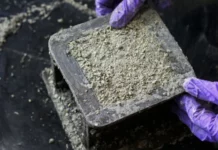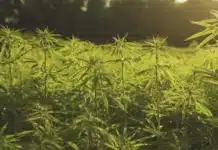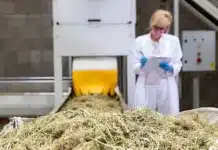The USU Extension office is getting questions from growers who are wondering about the feasibility of raising hemp in Utah. The interest seems to come from increasing dialogue in the Utah State Legislature and elsewhere of the potential medical qualities of marijuana. Some states have even approved the recreational use of cannabis. I have to respond that I know very little about the plant, but I have done some reading that may shed additional light on the potential of raising the crop in Utah.
There are many different varieties of the cannabis plant. Both hemp and marijuana come from the same cannabis species, but they are genetically distinct and further distinguished by use. Hemp was once used for making rope, paper, textiles, construction materials and cordage. In some cases, seeds and flowers from the plant were used in some health foods, livestock feeds, and nutraceuticals.
Once a major cash crop, hemp was outlawed in 1937 alongside marijuana, despite not having near the same level of the psychotropic chemical tetrahydrocannabinol (THC). The Marijuana Tax Act strictly regulated the cultivation and sale off all cannabis varieties — including hemp. As a result of this long-term prohibition, most people have forgotten the industrial uses of the plant and continue to misidentify hemp with its cannabis cousin, marijuana.
A growing interest in hemp was precipitated by the 2014 U.S. Farm Bill which allows individual states to reauthorize hemp farming. Some states, including Pennsylvania, Wisconsin, Kentucky and Oregon are already conducting hemp pilot projects. Pennsylvania, for example, approved 16 research projects with limited acreage in 2017. Their purpose was to re-learn how to raise hemp like their great-grandfathers once did. This year the state plans to approve 50 research projects that combined may cultivate 5,000 acres.
Wisconsin growers report that hemp is highly versatile, works well in a crop rotation and is relatively easy to grow, but markets have yet to be developed. Their advice is not to raise the crop unless a buyer is lined up and a legitimate contract is in place. Hemp is not a crop that can be taken to the local grain elevator where a grower can ask what the cash price is for the day.
In most cases, farmers don’t need special modifications to equipment for planting and harvesting industrial hemp. Hemp will grow on well-drained soils with good organic matter. Hemp also likes higher soil pH, almost in the acidic range. Hemp can be planted anytime the soil temperature reaches 50 degrees. Seed is planted to a depth of one-half to three-quarters of an inch, with rows spaced six to 10 inches apart and the seeding rate at 30 to 35 pounds per acre. Growers must be able to dry hemp seed to less than 9 percent moisture for long-term storage. That has proven to be difficult in some of the Wisconsin studies.
A recent news release from Utah Department of Agriculture and Food leads me to believe that a Utah market for hemp is yet a long ways off. “Because of FDA rules and guidelines established by the Association of American Feed Control Officials (AAFCO), feed products containing hemp are not recognized or approved for use as a feed ingredient and are considered to be adulterated and in violation of the Utah Commercial Feed Act and the Utah Wholesome Food Act.”
UDAF is asking manufacturers to voluntarily recall previously distributed products and to stop future sales and manufacturing in this state. Utah is joining Texas, Colorado, Washington and other states in issuing this notice.
UDAF officials said: “There are many unanswered questions about how the ingredients in hemp could interact with large and small animals. Until sufficient peer-reviewed science is presented and the FDA and AAFCO have accepted them as an approved animal feed ingredient, the UDAF will continue to prohibit the manufacturing and distribution of the adulterated products. According to the AAFCO, allowing an industry to enter the market without the appropriate safety data is unfair to other ingredient manufacturers that are doing their due diligence. There are some potential safety concerns related to the presence of certain compounds, including THC (tetrahydrocannabinol) and CBD (cannabidiol), in parts of the hemp plant that must be addressed.”
In my younger days as an undergraduate student, I remember one of my professors teaching us that three criteria had to be met before any venture could be a success. First, it had to be technically possible; second, it had to be economically feasible; and finally the idea had to be socially acceptable.
The more I study the production and marketing of hemp the more I am seeing that it’s time as a viable cultivated Utah crop has not yet come.














